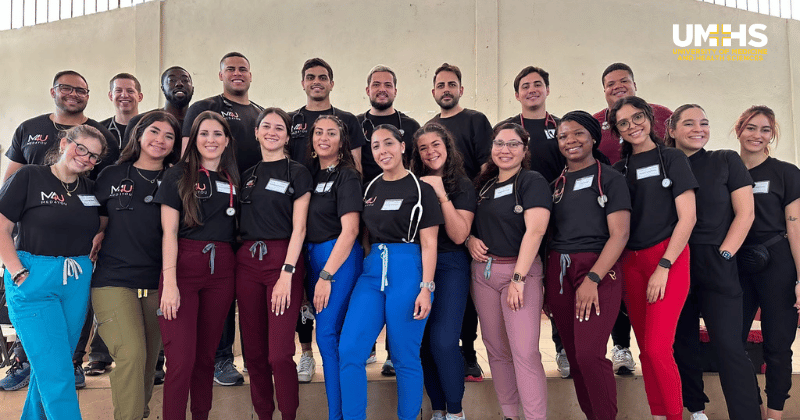UMHS students from the Med4You club traveled to Costa Rica in late April as part of a mission trip with the UMHS Global Health Institute and Vida Volunteers to bring badly needed healthcare services to an MUA (medically underserved area) in the Central American nation.
The UMHS Endeavour spoke to three students—Roberto K. Negron Laguna, EBS5 and Neishalis Muniz, EBS4 and Jairo J. Camacho Rivera, EBS5 and Med4You President Spring 2023 and DIRIG Vice President Spring 2023— about the trip and how working with patients in a remote area of Costa Rica was such a valuable learning experience, and why there is a need to continue doing humanitarian healthcare work in developing countries. We also spoke to Dr. Jagadeesh Nagappa, a UMHS Professor of Physiology who is the Director of the Global Health Institute and advisor to the student organization Med4You. Dr. Nagappa and the UMHS Global Health Institute and Med4You are planning upcoming medical mission trips to MUAs in various countries.
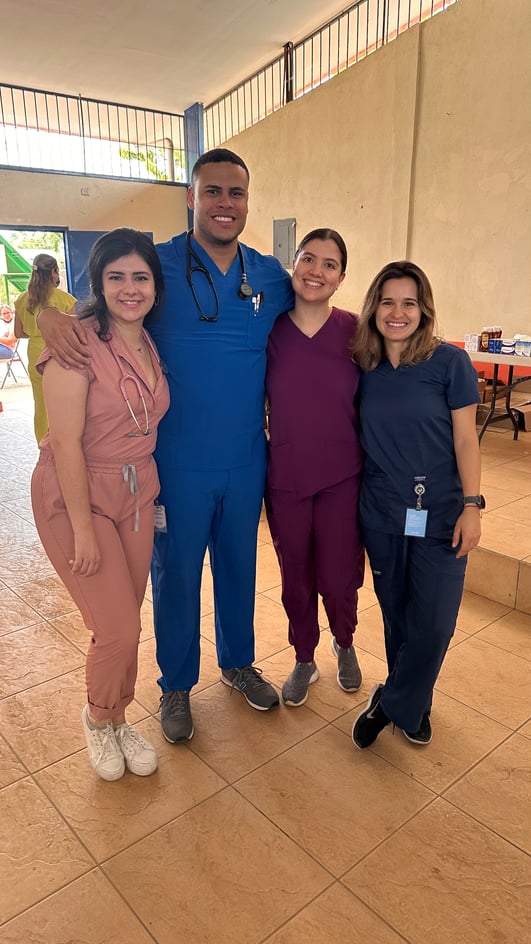 Roberto K. Negron Laguna (center) with (left to right) Dr. Andrea Melendez, Dr. Carolina Brenes & Dr. Maria Luisa Ulloa. The doctors accompanied UMHS students during the health clinics. The doctors were a valuable source of knowledge for students & helped tremendously during the mission trip to Costa Rica. Photo: Courtesy of Roberto K. Negron Laguna.
Roberto K. Negron Laguna (center) with (left to right) Dr. Andrea Melendez, Dr. Carolina Brenes & Dr. Maria Luisa Ulloa. The doctors accompanied UMHS students during the health clinics. The doctors were a valuable source of knowledge for students & helped tremendously during the mission trip to Costa Rica. Photo: Courtesy of Roberto K. Negron Laguna.
Humanitarian help in Costa Rica
UMHS Endeavour: You recently participated in the medical mission trip to Costa Rica. What were the main reasons you wanted to go help patients there?
Roberto K. Negron Laguna, EBS5: I have always been interested in helping people in many ways, for me as a person I understand that you can help anyone with a “good morning” or “how are you?” as simple as it sounds it can change anyone’s perspective on their day or even life. The little things matter. Being in medical school has solidified my perspective and the idea of helping others. Since then, my thoughts have changed in how to help someone in a distressed situation. I would think going to Costa Rica as a medical student might be scary, I was doubting myself. Not sure as a medical student if I was going to be able to help the patients in distress. Many thoughts come to your mind as in what you might encounter or what your challenges may be. However, the urges and fire that I had inside my heart helped me overcome that fear and those thoughts. I have two amazing parents who raised me, and since I have a memory, I have seen how my parents always help others. It’s like a tattoo that gets imprinted on yourself, as a person I have always tried to copy them. What’s better than flying somewhere during school break to go outside of your comfort zone to the aid of someone that you don’t know and have never seen in your life. I found that there is no better feeling and reason to not go and help someone in distress. That fire and urge my parents embedded in me is what drove me to go to Costa Rica and complete this humanitarian mission.
Neishalis Muniz, EBS4: I went from April 25 to May 1st. My main reason for going to Costa Rica was because I always wanted to be part of Doctors Without Borders. I myself have done mission trips and large community events to help people. However, my interest in Costa Rica was that it was a new place I have never visited before. I love to help those in need and I feel like it's our job as future doctors, as humans, to help those in need if you have the opportunity to do so. I happily would’ve gone to any place as long the criteria was to help patients. Also, I love to see how there can be differences in health care, in comparison with different countries. I was open to anything and was interested to learn and grow in my skills and in my experiences.
Jairo J. Camacho Rivera, ESB5: Since I joined UMHS, I have always heard about different students having the experience of going abroad and serving other countries and at the same time putting into practice the knowledge that they have learned until then. Therefore, when last semester we as the Executive Board decided that the Costa Rica Trip was going to take place, I didn’t think twice about it and joined them. I don’t regret my decision. Attending this trip helped me after e two years of being a medical student to reaffirm that this is my passion. Not only I was able to do what I love, but I was able to put into practice all I have learned and give the patient a piece of knowledge so they can modify their life.
Can you please give one or two examples of how the mission trip to Costa Rica opened your eyes to the healthcare needs of medically underserved areas?
Roberto K. Negron Laguna, EBS5: There are so many stories I could tell from this trip but there’s always a couple that get imprinted in your heart. On this trip, I experienced true love and respect. I attended a family of three composed of a mother and her two children. They came for a regular check-up and I could see that the kids needed some clothing and school materials. After conducting their check-ups, I noticed that the three-year-old, the youngest, had stunted growth, meaning he had the weight of a one-and-a-half-year-old child compared to a three-year-old. When asking the mom, we learned that their diet had a multivitamin deficiency in all the members of the family. When asked further we found out they only ate once a day with whatever they were able to find. Learning this, I gathered some of the clothing and school supplies I brought for the kids and gave them to the family. We ended up giving the family multivitamins and educated the mom on how this could be dangerous for her kids as well as understanding their situation. After we were done with everything, both kids came and gave me a big hug and said “thank you, doctor” and for me that was the most rewarding and humble experience I had in a long time.
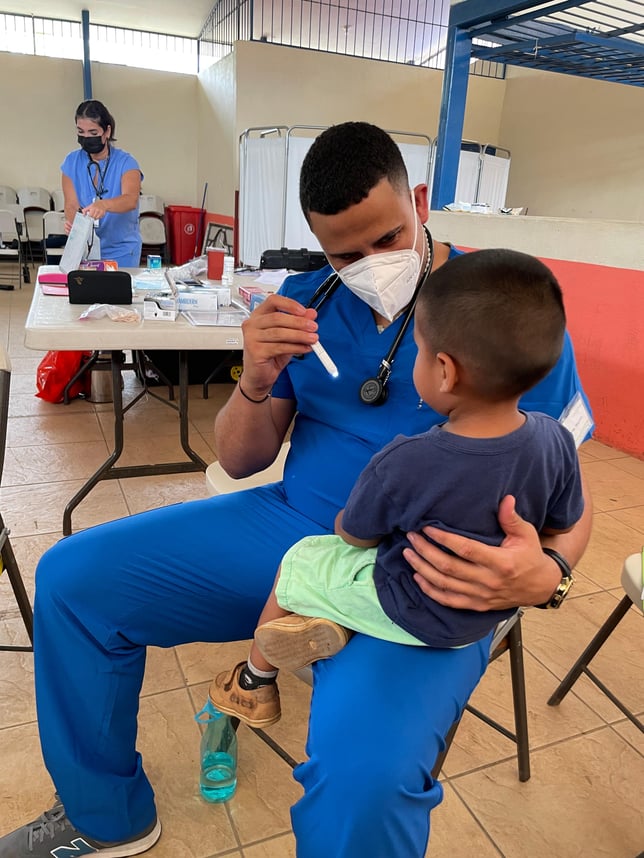 "This is Isaac, my patient with stunted growth. He was so joyful and thankful for the help we gave, a memory I will never forget," said Roberto K. Negron Laguna. Photo: Courtesy of Roberto K. Negron Laguna.
"This is Isaac, my patient with stunted growth. He was so joyful and thankful for the help we gave, a memory I will never forget," said Roberto K. Negron Laguna. Photo: Courtesy of Roberto K. Negron Laguna.
I have another story. I met Sofia and her mom in the clinic the same day I met Isaac. I decided to give Sofia some school supplies and a good speech on how strong she was at 12 years of age. How powerful she could be and how she can be anything that she wanted to do in life, whatever she wanted, she could do it. It was an amazing talk with Sofia. I felt like a big brother giving a speech to her. But I knew that sometimes these talks could change anyone's life, which it was what happened in my case a couple years ago with a good friend of mine who pushed me to apply to UMHS and the rest is history. After our regular check up with Sofia and her mom they left to go home. But sometime later, Sofia returned with her little brother and she could not remember my name and was asking for the “Giant Doctor” I am 6’3,” which makes me a little bit taller than my surrounding peers. While I found it funny, the way she described me, she came with her little brother to see if I could give something for him for school. My heart automatically melted with joy and happiness, and of course I had something for him. He was so shy to accept my gift but I initiated a conversation with him and gave him the same speech I gave his sister and told him that he could be a doctor one day. I told him all he needed was to dream about it and everything was going to be easy for him. Before leaving we took a picture and they both gave me the most warm and special hug I have ever had. My heart was so full of love and happiness at that moment. I wish I could describe more of those feelings but I think this picture will make justice to it.
Neishalis Muniz, EBS4: I was able to see things that might seem simple to us are not so simple in other places. I was able to see the disparities in healthcare. It's not easily accessible to people. Poverty in Costa Rica made it hard to even have an annual checkup. When we went to Costa Rica, we learned the different problems many people had. The village of La Garita is a place where it's mainly in the mountains, away from the city with little access to healthcare. The people from the area work in agriculture. The majority of the men work in the fields, and in plantations. The majority of the women were housewives and almost all the women we met had more than two children. We saw that economically these were people that had little financial security. Most of them were undocumented people originally from Nicaragua. Since they were people with no green card, they had zero access to insurance, social security, and therefore no access to healthcare. We saw how the system over there was not flexible, and was not willing to help those in need no matter of social status or nationality. I think that was the big difference I saw. It definitely made me very thankful to be privileged, and have the ability to be a US citizen and have a system that might not be perfect but have things that make it easier to access for most of the population. I'm glad I am learning about the differences within countries and how things can be so different according to location, nation, and the whole health infrastructure.
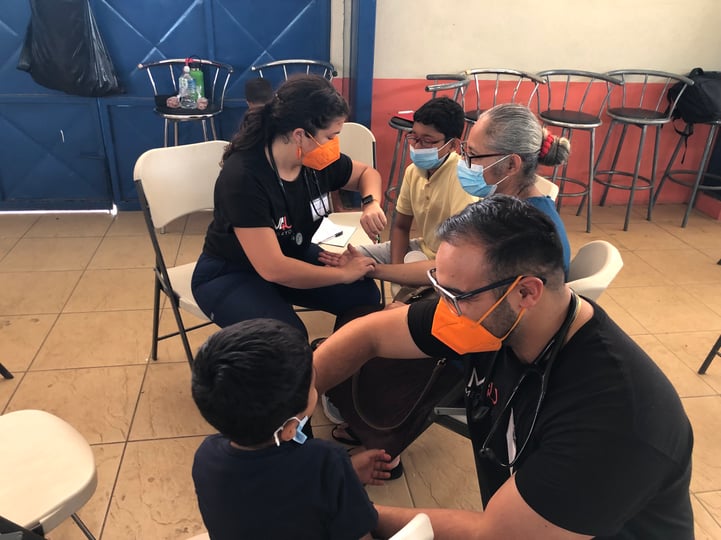 Med4You President Spring 2023 Jairo J. Camacho Rivera (top right) treats a young patient at the Costa Rican clinic while another UMHS volunteer works with two other patients. Photo: Courtesy of Jairo J. Camacho Rivera.
Med4You President Spring 2023 Jairo J. Camacho Rivera (top right) treats a young patient at the Costa Rican clinic while another UMHS volunteer works with two other patients. Photo: Courtesy of Jairo J. Camacho Rivera.
Jairo J. Camacho Rivera, ESB5: I have been on other mission trips to other countries but this one was unique. Two examples that opened my eyes were:
How Nicaraguan immigrants walked for more than eight hours to be treated in our clinics compared with patients in the States or even Puerto Rico, who skip physician appointments because simply they aren’t compliant with their health.
Another eye-opening experience was when the doctors in Costa Rica congratulated us because of our performance and the way we ran the clinic. They were shocked, because of how we were able to do all the history taking, physical exams, diagnosis, and treatment. We leave every single day of clinics with our heads up and proud of what we have done but most importantly, of the way our school is preparing us.
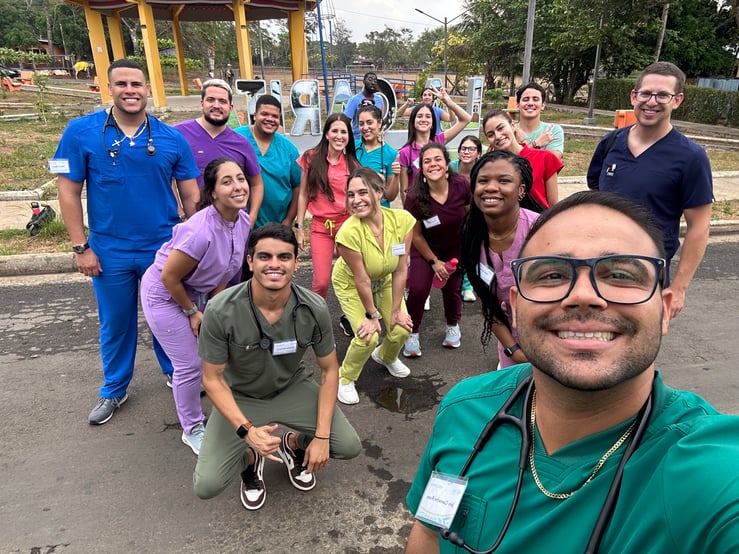 Jairo J. Camacho Rivera with the Med4You volunteer team in Costa Rica. Photo: Courtesy of Jairo J. Camacho Rivera.
Jairo J. Camacho Rivera with the Med4You volunteer team in Costa Rica. Photo: Courtesy of Jairo J. Camacho Rivera.
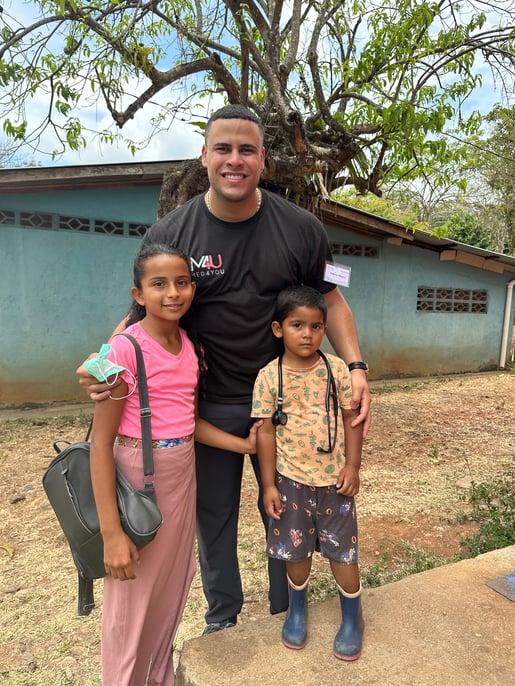 Local Costa Rican children with UMHS student Roberto K. Negron Laguna. Photo: Courtesy of Roberto K. Negron Laguna.
Local Costa Rican children with UMHS student Roberto K. Negron Laguna. Photo: Courtesy of Roberto K. Negron Laguna.
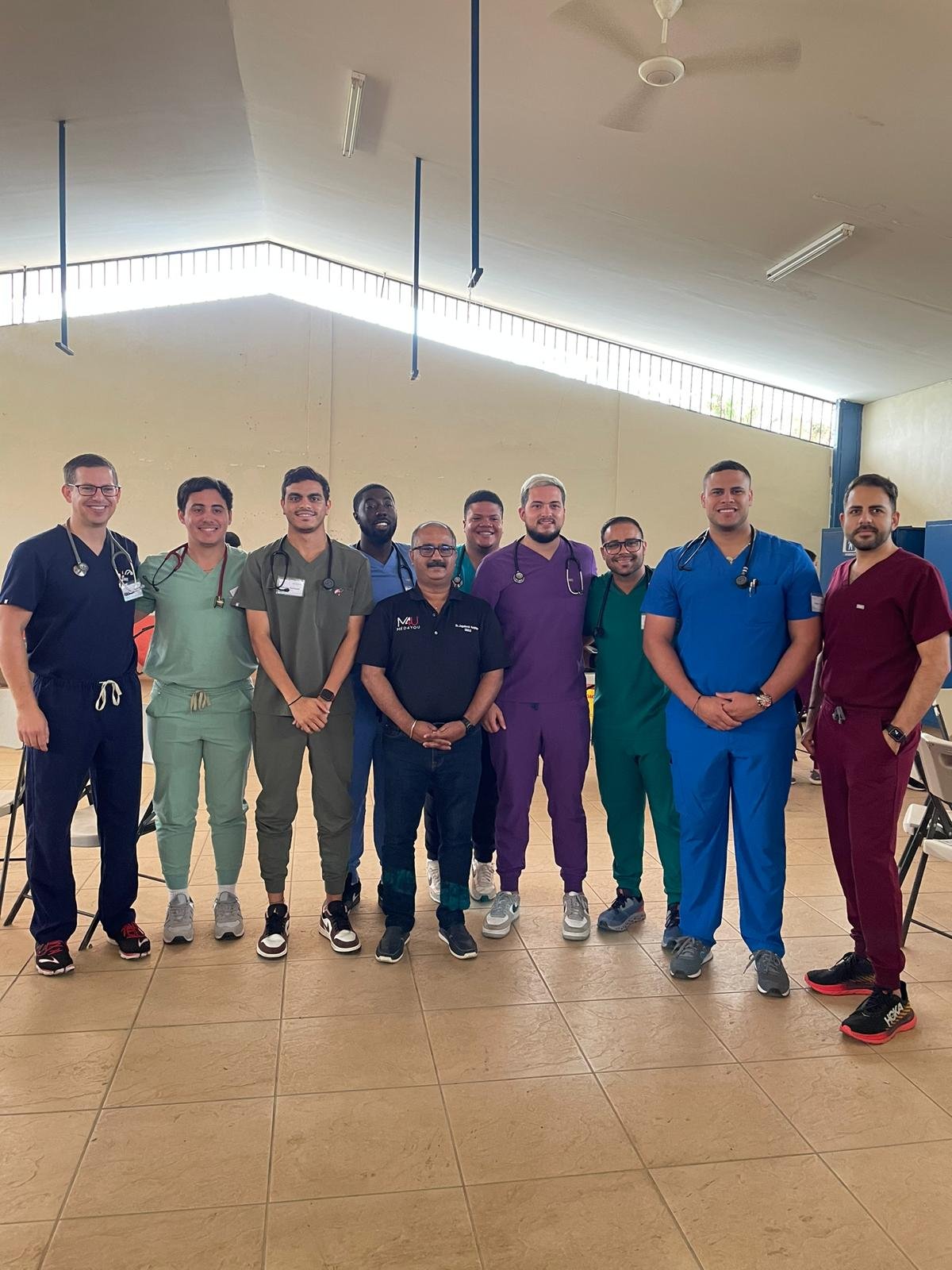 Group shot of the UMHS Med4You team with UMHS professor Dr. Jagadeesh Nagappa (center) in Costa Rica. Photo: Courtesy of Roberto K. Negron Laguna.
Group shot of the UMHS Med4You team with UMHS professor Dr. Jagadeesh Nagappa (center) in Costa Rica. Photo: Courtesy of Roberto K. Negron Laguna.
Treating special medical needs in remote areas
Statistics say cardiovascular disease and cancer are the two main causes of death in Costa Rica. Is it true the country has strong Primary Care but struggles to meet the urgent demands of specialized treatment in rural areas. Do you agree with this and from your experience, and what are things people in Costa Rica need to improve health outcomes in rural areas? Be as specific as possible.
Roberto K. Negron Laguna, EBS5: Sadly, I agree and this is so true, especially the immigrant patients from Nicaragua that do not have social security and can’t go to a health clinic to have medical care due to their migratory status. These rural areas are so far away from the nearest hospital that anyone with a heart attack or asthma attack would not have the same survival chances. There is a need for a hospital in these areas as well as education to the community on signs and symptoms to identify in a person with medical distress; such as hypertension, menopause, diabetes, asthma, seizures, and epileptic attacks. There is a big need for doctors overall in Costa Rica. The demand is higher than the number of doctors available. I would say they need to pay more attention to the doctor’s pay and the education of the population. Have a way to deliver more medical aid to the immigrants from Nicaragua, they only have these non-profit organizations, and programs like the one we were involved in to help those communities.
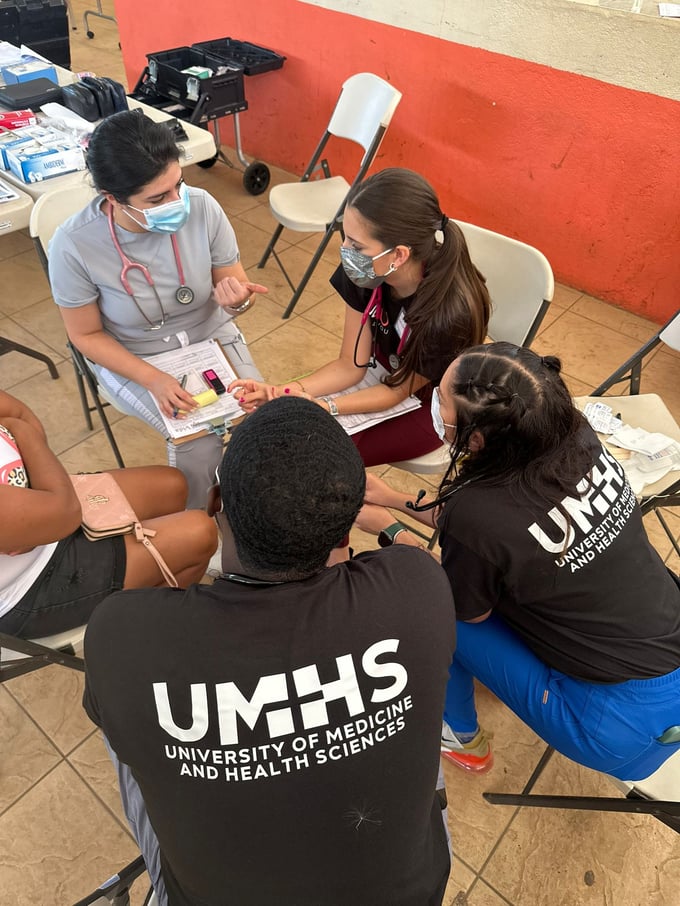 Neishalis Muniz briefing one of the doctors from the clinic, discussing what they thought a potential diagnosis was & what treatment to give the patient. Photo: Courtesy of Neishalis Muniz.
Neishalis Muniz briefing one of the doctors from the clinic, discussing what they thought a potential diagnosis was & what treatment to give the patient. Photo: Courtesy of Neishalis Muniz.
Neishalis Muniz, EBS4: In Costa Rica, all that have citizenship have access to insured health care; they can receive primary care. However, with that type of system intact, it's hard to treat everyone, especially if they need to have a certain procedure done, or if they have a chronic condition, it is much harder to attend to everyone. We saw that there were people that went to their primary care doctor, had access to healthcare, but their needs were not being met. We saw people that had chronic conditions, but did not have their procedures done, or didn't have access to receive their treatments. There were people that had chronic conditions with scheduled appointments or procedures, but their appointments were not until many months later. It was tough to see their desperation and honestly not being able to help them, was harder. Again, it was a unique experience to see the differences the healthcare system can be in a different country. Being in a rural area makes it so much harder for people to get the care they need. Just due to location and the impediment they might have financially.
Jairo J. Camacho Rivera, ESB5: I 100% agree with the statistics. From my experience, some things need to be changed for example one of them is transportation. People walk for more than two hours to see their nearest specialist and sometimes they need to wait for more than two months for their appointment to be seen. The other two are insurance and developing a way so the Nicaraguan immigrants that are arriving in those rural areas get befits. The insured as in the USA only covers one part but honestly, these communities are far from being able to cover everything. Regarding the Nicaraguan immigrants, the government can do a program so they can benefit from it until they get settled into the country and have a way to pay for their health services, etc.
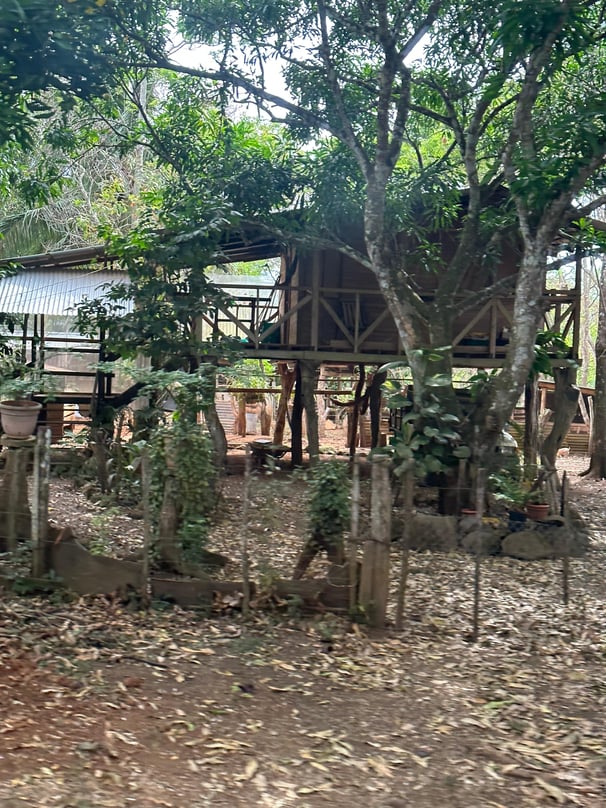 A house in Costa Rica. Many patients the students treated live in dwellings like this. Photo: Courtesy of Neishalis Muniz.
A house in Costa Rica. Many patients the students treated live in dwellings like this. Photo: Courtesy of Neishalis Muniz.
You treated a variety of ages in Costa Rica, from young children to the elderly. What were some of the most common medical issues you saw there?
Roberto K. Negron Laguna, EBS5: Asthma, hypertension, scabies, eczema, hyperthyroidism, chronic heart failure, diabetes, COPD, rheumatoid arthritis, and menopause.
Neishalis Muniz, EBS4: The most common medical issues we saw were respiratory problems, gastritis, skin problems. For the adults there were many that had skin problems since they spent the majority of their day in the sun. There were a lot of respiratory problems as well, mainly asthma. Many of the problems we did see was the ignorance, or the lack of knowledge they had on certain criteria or things that had to do with their health. We had women that did not understand how birth control medication was supposed to be taken, and they were so confused on why they kept becoming pregnant. We had people that had asthma and had their prescribed inhalers, but did not know how to take the medication.
Jairo J. Camacho Rivera, ESB5: The common medical issues that we deal with were Type 1 and 2 diabetes, hypertension, different types of fungal infections specifically in the feet, and urinary tract infections.
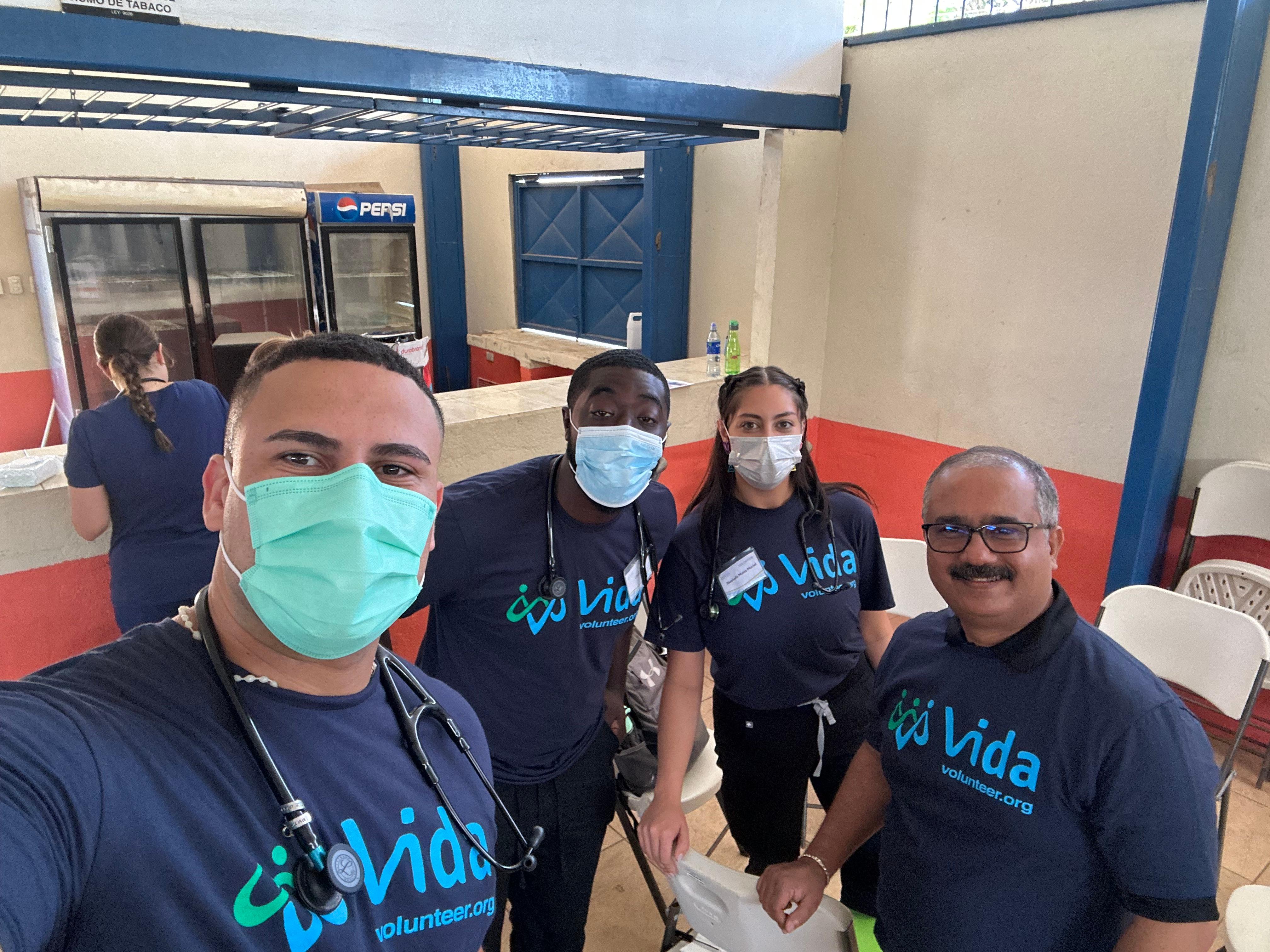 Roberto K. Negron Laguna (far left) with Vida Volunteers & (far right) Director of the UMHS Global Health Institute Dr. Jagadeesh Nagappa in Costa Rica. Photo: Courtesy of Roberto K. Negron Laguna.
Roberto K. Negron Laguna (far left) with Vida Volunteers & (far right) Director of the UMHS Global Health Institute Dr. Jagadeesh Nagappa in Costa Rica. Photo: Courtesy of Roberto K. Negron Laguna.
What are some things you’ve learned not only from the Costa Rica trip but also working with Med4You at UMHS?
Roberto K. Negron Laguna, EBS5: I have learned that people should always be heard , no one is above anyone. There is no better leader than that who commands and points but also does the work as well. They are willing to help others. I learned that the end goal is not just for us, we are doing this for something bigger than ourselves.
Neishalis Muniz, EBS4: When in Costa Rica and working with the rest of the Med4You members, I was able to see that here at UMHS we are getting prepared very well. We are learning all the tools and all the information we need to help patients and treat their necessities. When talking with the doctors from the program they expressed to us that they were so impressed with our skills and they honestly thought we were very prepared and equipped to do our own diagnosing, prescribing and treating the patients. However, I feel like I learned so much from the other doctors, and learned to identify the signs of certain conditions. The best of all was the exposure we were able to have with different types of patients. The experience gained is something that one can get in a classroom. I was able to build my skills in communication, interviewing, and my confidence in the path I am in right now as a medical student.
Jairo J. Camacho Rivera, ESB5: Some of the things that I have learned with Med4You are empathy, teamwork, and how to educate others at different levels of educations. And most importantly how anyone can develop as a leader if you really want to be one.
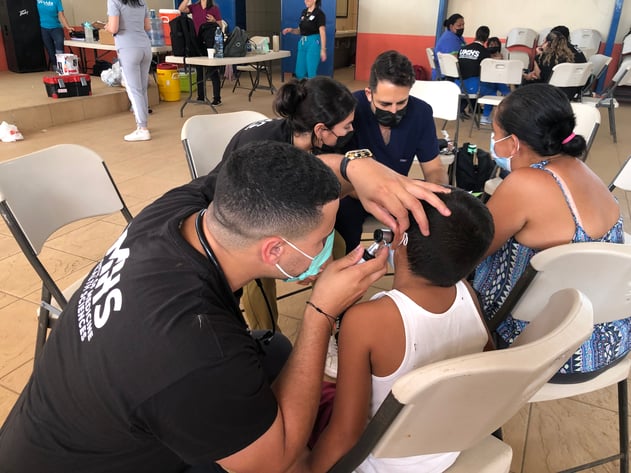 Roberto K. Negron Laguna with a patient at the Costa Rican clinic. Photo: Courtesy of Roberto K. Negron Laguna.
Roberto K. Negron Laguna with a patient at the Costa Rican clinic. Photo: Courtesy of Roberto K. Negron Laguna.
How UMHS students can help in MUAs
Can you tell us some of the ways your organization and UMHS are helping support medically underserved areas (MUAs) like the region of Costa Rica you visited? Do you have plans to do mission trips again in Costa Rica or in other countries?
Roberto K. Negron Laguna, EBS5: Yes, in this current trimester we are planning to replicate what Med4You did in Costa Rica here in St. Kitts. To give the chance to more students to expose themselves here in the island and prepare them for the upcoming future. Giving them a boost of confidence that all the hard work in the classroom is paying off. We plan to impact different communities with the Ministry of Health to reach those in need here in St. Kitts.
Neishalis Muniz, EBS4: On this Costa Rica trip, members of the board and our head advisors gave donations for the children. These donations helped so many children, and it was amazing to see their happiness. We were able to give clothes, and school materials. We also have done events to help the community here on the island. Just like Costa Rica, I would love to keep giving back to the community. I would be so honored to have an experience like Costa Rica be repeated, whether it be in Costa Rica again or in any other country. I look forward to continuing community work and mission trips in the future. If I have the ability to do so, I would go every year on a mission trip. I recommend it to all I talk to and it’s an experience all should have.
Jairo J. Camacho Rivera, ESB5: Since we just basically reopened Med4You after COVID-19, this was our first trip. But, as an organization, we will be helping those underserved countries with medication, clothes donations, etc.
Is there anything else you want to add that we have not covered?
Neishalis Muniz, EBS4: Costa Rica was an amazing experience, I would recommend anyone to go on any future mission trip conducted by the Med4You club. I think that it is amazing that I had the opportunity to go on a mission trip to Costa Rica. I hope all the students at UMHS can have the same experience.
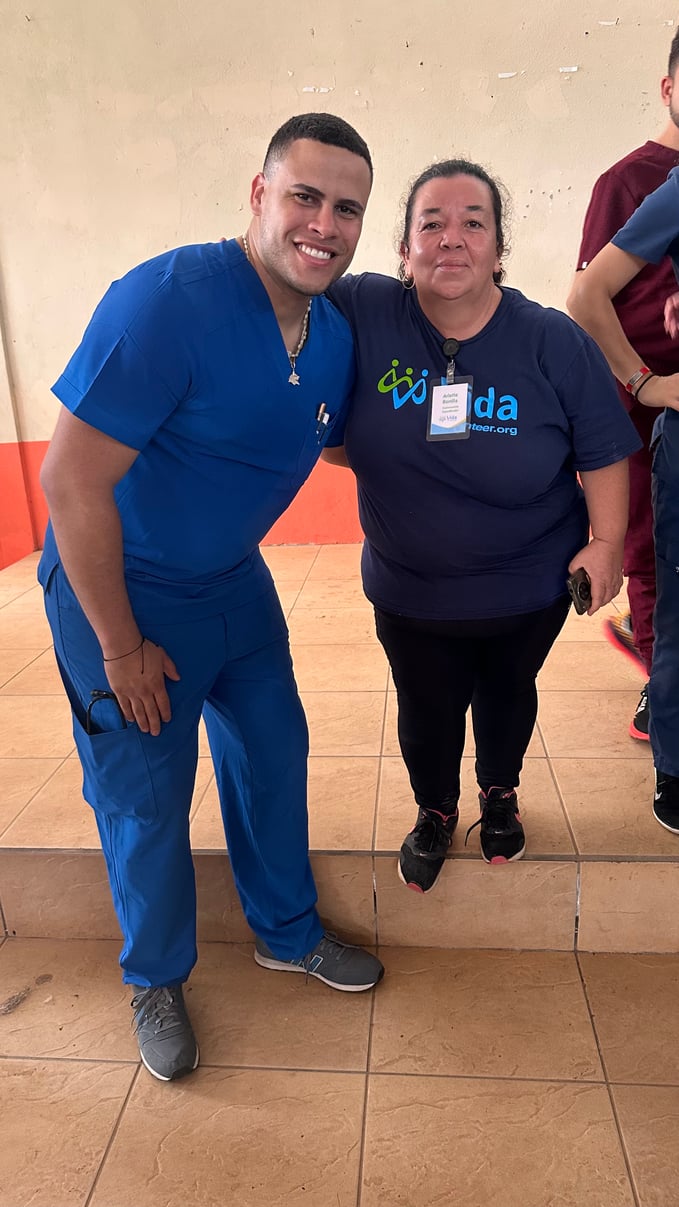 Roberto K. Negron Laguna with Arlette Bonita of Vida Volunteers. Photo: Courtesy of Roberto K. Negron Laguna.
Roberto K. Negron Laguna with Arlette Bonita of Vida Volunteers. Photo: Courtesy of Roberto K. Negron Laguna.
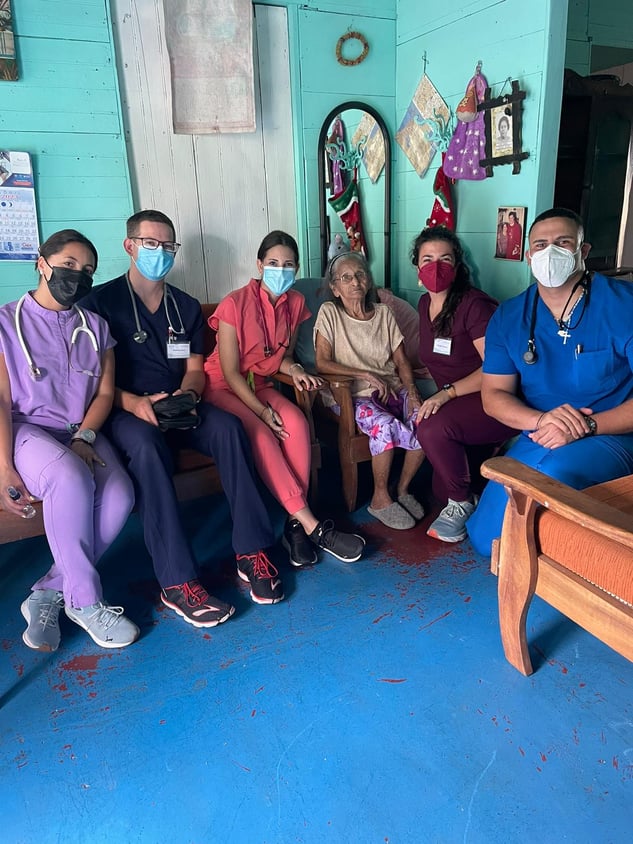 Roberto K. Negron Laguna (far right) & an elderly patient with other volunteers in Costa Rica. Photo: Courtesy of Roberto K. Negron Laguna.
Roberto K. Negron Laguna (far right) & an elderly patient with other volunteers in Costa Rica. Photo: Courtesy of Roberto K. Negron Laguna.
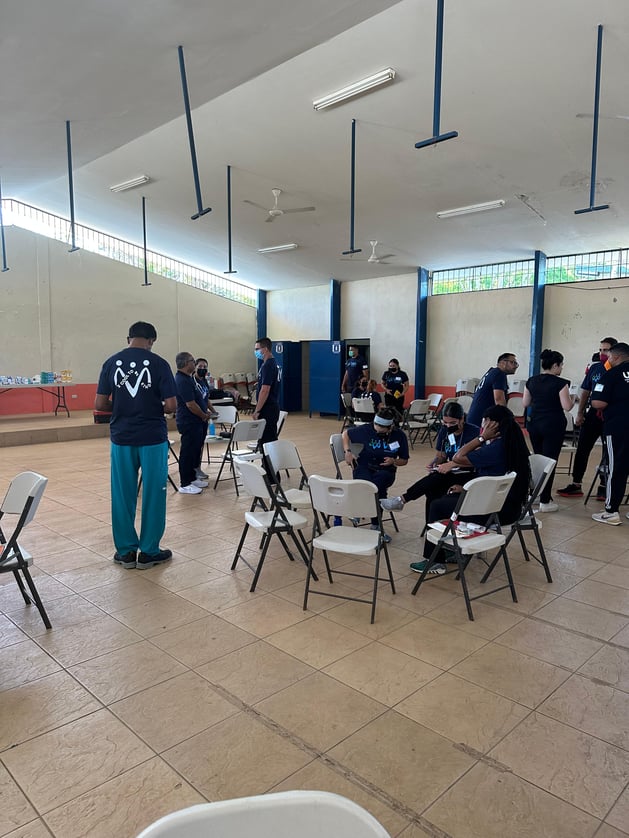
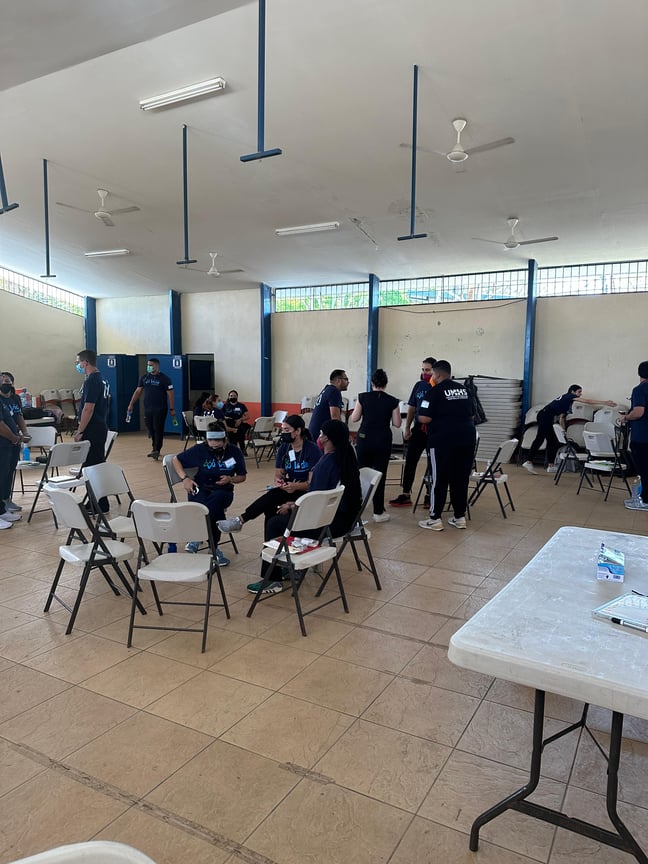 Two photos above: The clinic layout. The students were divided into groups, working with multiple patients at a time. Photos: Courtesy of Neishalis Muniz.
Two photos above: The clinic layout. The students were divided into groups, working with multiple patients at a time. Photos: Courtesy of Neishalis Muniz.
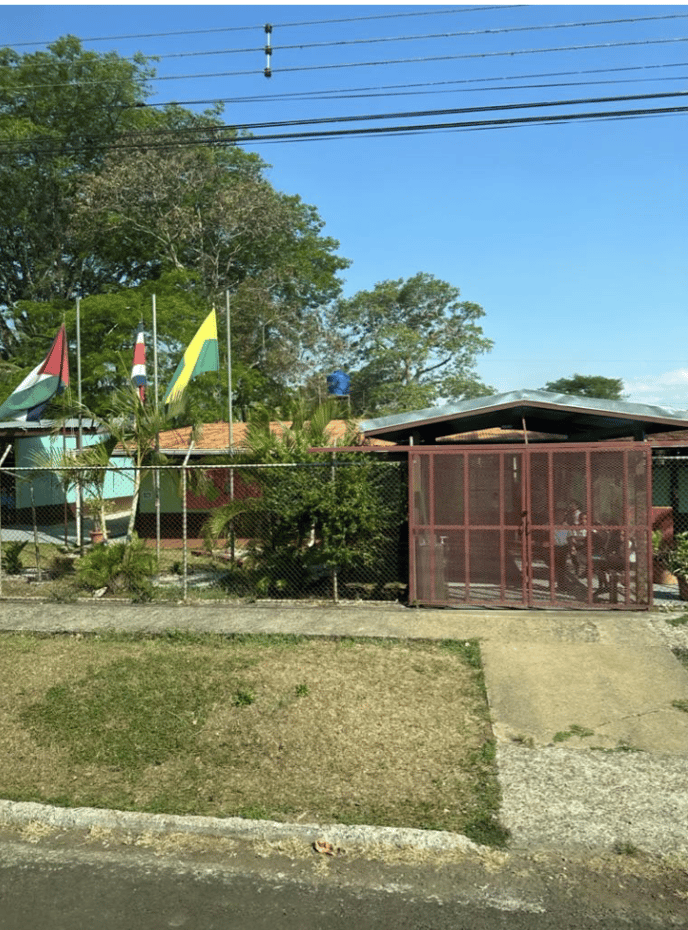 The school at La Garita Village. Photo: Courtesy of Neishalis Muniz.
The school at La Garita Village. Photo: Courtesy of Neishalis Muniz.
For information on Med4You, please email med4you.umhs@gmail.com
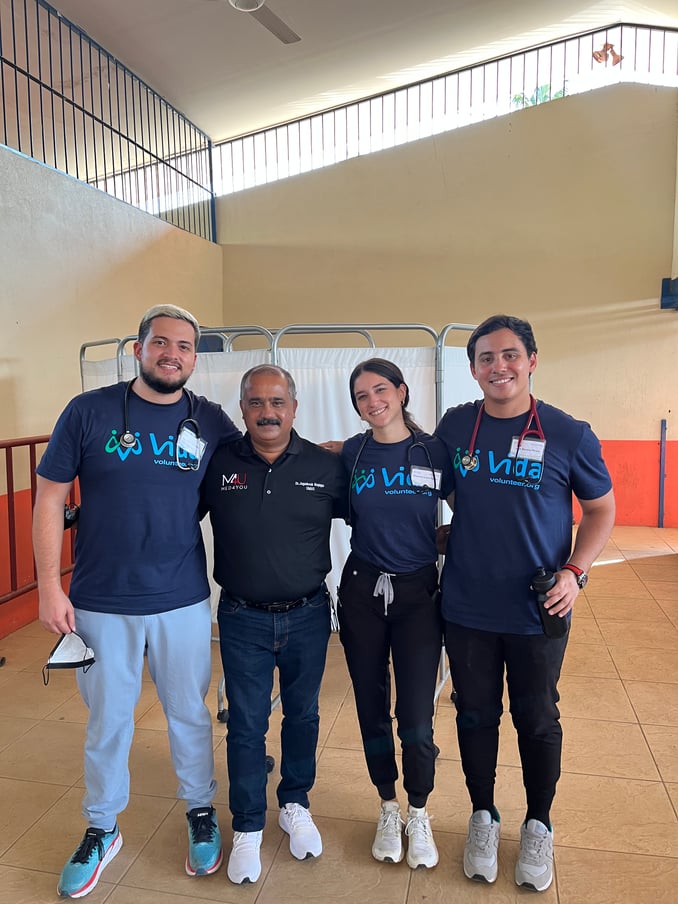 (Left to right): UMHS student Mario Nieves, Dr. Jagadeesh Nagappa (center) with UMHS students Alejandra Jusino & Juan Ramirez in Costa Rica. Photo: Courtesy of Dr. Nagappa.
(Left to right): UMHS student Mario Nieves, Dr. Jagadeesh Nagappa (center) with UMHS students Alejandra Jusino & Juan Ramirez in Costa Rica. Photo: Courtesy of Dr. Nagappa.
UMHS Global Health Institute
After a long absence due to the COVID-19 pandemic, UMHS has started its Global Health Institute once again, working with the student body in the group Med4You, first established by a UMHS student in 2017. Dr. Jagadeesh Nagappa, the Director of the UMHS Global Health Institute, will be organizing more medical mission trips around the world, working with the Med4You student organization.
"This Global Health initiative, supported and funded by the UMHS administration, provides students with practical and immersive training that encompasses diverse cultural and clinical aspects, expands knowledge about other cultures, and helps them gain a deeper understating of global health, and their personal development," Dr. Nagappa said. "Also, students have the opportunity to collaborate with physicians, participating in the diagnosis, treatment, and education of patients in diverse geographical locations around the world and locally in St. Kitts."
UMHS students participating in the mission trips get hands-on experience working with medically underserved communities.
"Through this program, students can observe a wide range of clinical cases, including diseases that are specific to the communities (countries) they visit, as well as general conditions found worldwide," Dr. Nagappa said. "Importantly, the medical program enhances students' cross-cultural communication skills, fosters respect for people from different backgrounds, and fills them with a sense of satisfaction that they are contributing to the rural communities where health services are not available."
Med4You has successfully organized several international medical volunteer trips, each trip consisting of approximately 15-22 students and two faculty members. Past trips are listed below:
- Zacapa, Guatemala in 2017.
- Antigua, Guatemala in 2018.
- Puerto Rico in 2018.
- Boca Chica, Dominican Republic in 2018.
- Lima, Peru in 2019.
- Liberia, Costa Rica in 2019.
- Liberia, Costa Rica in 2023.
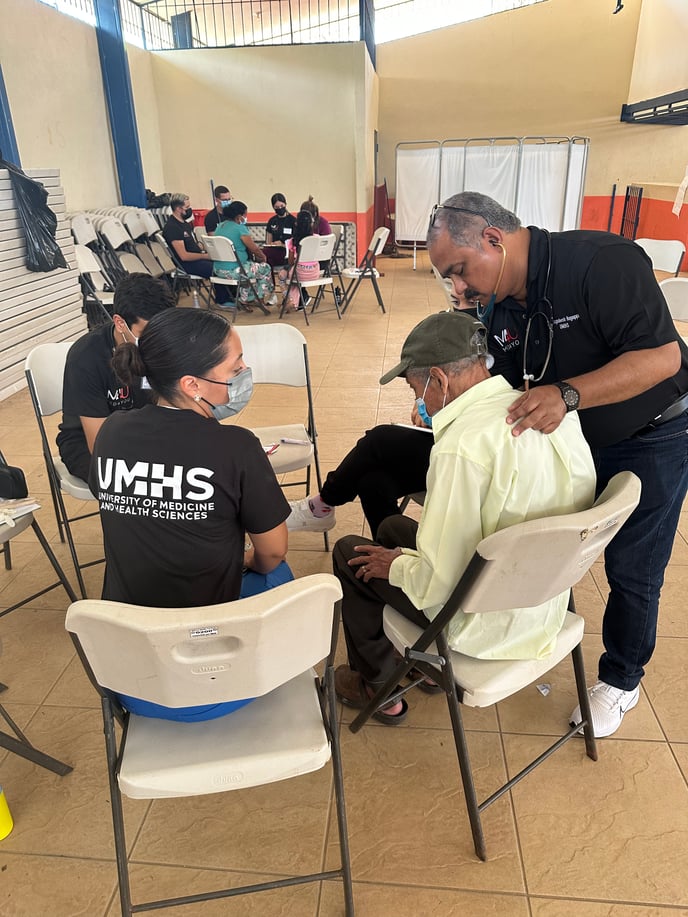 Dr. Jagadeesh Nagappa works with a patient in Costa Rica as UMHS Med4You student volunteers observe. Photo: Courtesy of Dr. Nagappa.
Dr. Jagadeesh Nagappa works with a patient in Costa Rica as UMHS Med4You student volunteers observe. Photo: Courtesy of Dr. Nagappa.
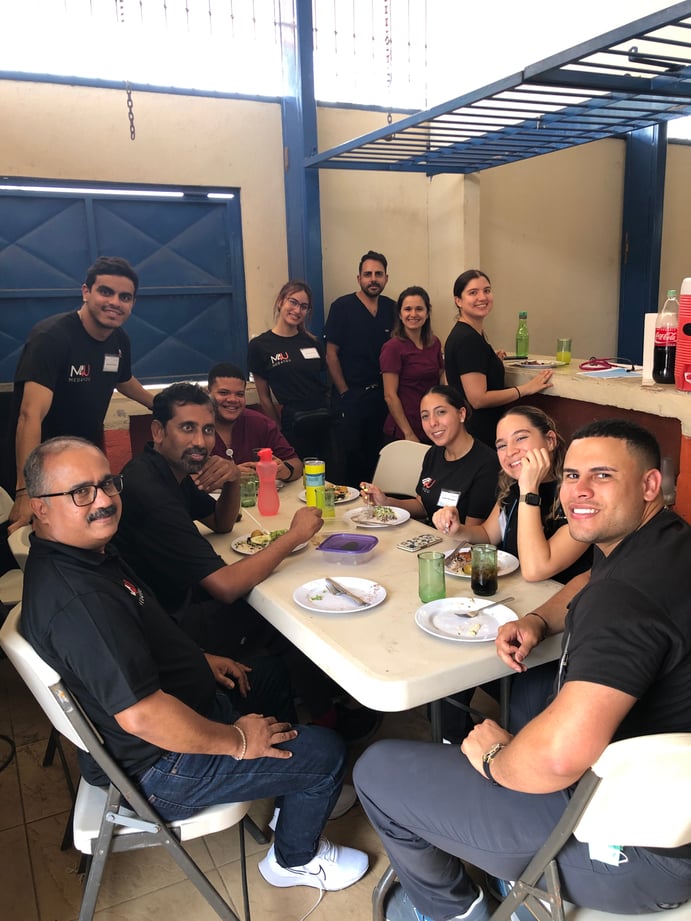 Dr. Jagadeesh Nagappa (bottom left) & (left to Dr. Nagappa) is Dr. Veera Gowda, enjoying a meal with UMHS Med4You student volunteers in Costa Rica. Photo: Courtesy of Dr. Nagappa.
Dr. Jagadeesh Nagappa (bottom left) & (left to Dr. Nagappa) is Dr. Veera Gowda, enjoying a meal with UMHS Med4You student volunteers in Costa Rica. Photo: Courtesy of Dr. Nagappa.
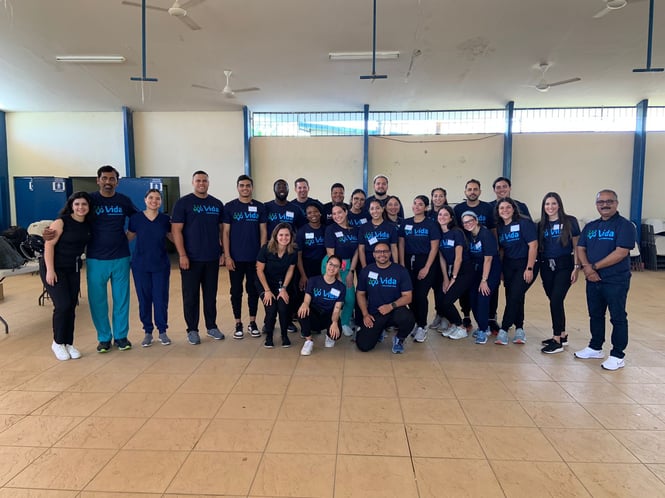 Group photo of UMHS Med4You volunteers with (far right) Dr. Jagadeesh Nagappa. Photo: Courtesy of Dr. Nagappa & Med4You.
Group photo of UMHS Med4You volunteers with (far right) Dr. Jagadeesh Nagappa. Photo: Courtesy of Dr. Nagappa & Med4You.
(Top photo) UMHS Med4You student volunteers in Costa Rica. Photo: Courtesy of Med4You.

Scott is Director of Digital Content & Alumni Communications Liaison at UMHS and editor of the UMHS Endeavour blog. When he's not writing about UMHS students, faculty, events, public health, alumni and UMHS research, he writes and edits Broadway theater reviews for a website he publishes in New York City, StageZine.com.













